Vastus medialis exercises target the teardrop-shaped muscle in the thigh, essential for knee stability and extension. These exercises, including isometrics and inner range strengthening, enhance knee function and reduce injury risk.
1.1 Definition and Role of Vastus Medialis
The vastus medialis, often referred to as the “teardrop muscle,” is a key component of the quadriceps femoris group. It is located on the medial (inner) aspect of the thigh and plays a critical role in knee extension and stabilization. This muscle is essential for maintaining proper patellar (kneecap) alignment and ensuring smooth movement of the knee joint. Its oblique fibers, known as the vastus medialis oblique (VMO), are particularly important for controlling the patella during activities like walking, running, or climbing stairs. Weakness or imbalance in the vastus medialis can lead to knee instability and conditions such as patellofemoral pain syndrome. Strengthening this muscle is vital for overall lower limb function and athletic performance.
1.2 Importance of Vastus Medialis in Knee Stability
The vastus medialis plays a pivotal role in maintaining knee stability by controlling patellar tracking and ensuring proper alignment during knee movements. Its oblique fibers, particularly the VMO, are crucial for preventing patellar malalignment, which can lead to conditions like patellofemoral pain syndrome. Weakness in this muscle often results in poor knee mechanics, increasing the risk of injuries and degenerative joint conditions. Strengthening the vastus medialis enhances knee joint stability, improves functional movement, and reduces the likelihood of chronic knee pain. This makes it essential for both athletic performance and everyday activities, ensuring efficient and injury-free knee function.
1.3 Overview of Vastus Medialis Exercise Benefits
Engaging in vastus medialis exercises offers numerous benefits, including enhanced knee stability, improved patellar tracking, and reduced risk of knee injuries. These exercises strengthen the VMO, crucial for activities requiring knee extension and stabilization. Regular practice can alleviate symptoms of patellofemoral pain syndrome and knee osteoarthritis by improving joint mechanics and reducing pain. Strengthening this muscle also boosts athletic performance, particularly in sports involving running, jumping, or quick directional changes. Additionally, vastus medialis exercises promote better posture and overall lower limb alignment, contributing to long-term joint health and functionality. Consistent training can prevent cartilage loss and lower the risk of needing joint replacement surgeries, making it a vital component of both rehabilitation and preventive fitness routines.
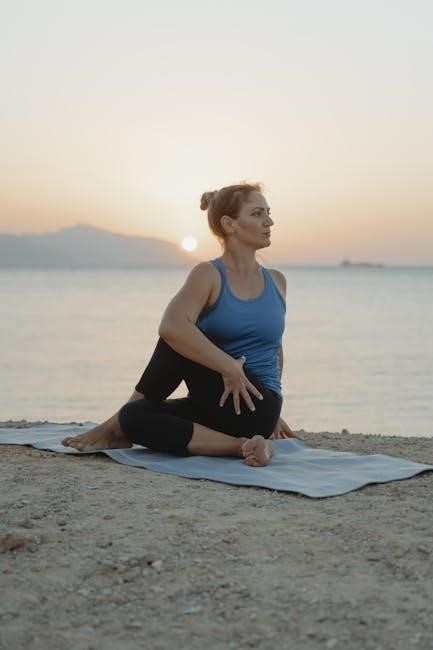
Anatomy of the Vastus Medialis Muscle
The vastus medialis is a teardrop-shaped muscle in the medial thigh, part of the quadriceps group. It plays a key role in knee extension and patellar stabilization.
2.1 Location and Structure of the Vastus Medialis
The vastus medialis is located on the medial aspect of the thigh, originating from the femur and ilium. It consists of two parts: the vastus medialis oblique (VMO) and the vastus medialis longus. The VMO is diagonally oriented, playing a crucial role in patellar tracking, while the longus contributes to knee extension. Its teardrop shape is distinct, with fibers converging into a central tendon that merges with the quadriceps tendon, ultimately inserting into the patella and tibia via the patellar tendon. This anatomical structure allows the muscle to stabilize the knee during extension and prevent lateral patellar subluxation, making it vital for proper knee mechanics and overall lower limb function.
2.2 Vastus Medialis Oblique (VMO) and Its Function
The vastus medialis oblique (VMO) is a distinct portion of the vastus medialis muscle, characterized by its oblique fibers. It plays a pivotal role in patellar tracking, ensuring the kneecap moves smoothly within the femoral groove during knee extension and flexion. The VMO is particularly active during the final stages of knee extension, helping to stabilize the patella medially. This function is crucial for preventing patellofemoral pain syndrome and maintaining proper knee alignment. Weakness or dysfunction in the VMO can lead to knee instability and injuries, making targeted strengthening exercises essential for athletes and individuals with knee-related conditions. The VMO’s unique fiber orientation allows it to generate significant medial pull, which is vital for balanced quadriceps function and overall lower limb mechanics.
2.3 Relationship Between Vastus Medialis and Quadriceps
The vastus medialis is one of four muscles in the quadriceps group, working synergistically to extend the knee. It plays a unique role in stabilizing the patella during movement. While the quadriceps primarily focus on knee extension, the vastus medialis ensures proper patellar tracking, preventing lateral displacement. Its oblique fibers provide medial pull, balancing the lateral forces from the vastus lateralis. This coordinated action is essential for efficient knee function and injury prevention. Weakness in the vastus medialis can disrupt quadriceps harmony, leading to patellofemoral pain and instability. Strengthening exercises often target the vastus medialis to restore balance and optimize quadriceps performance, highlighting its critical role within the group.
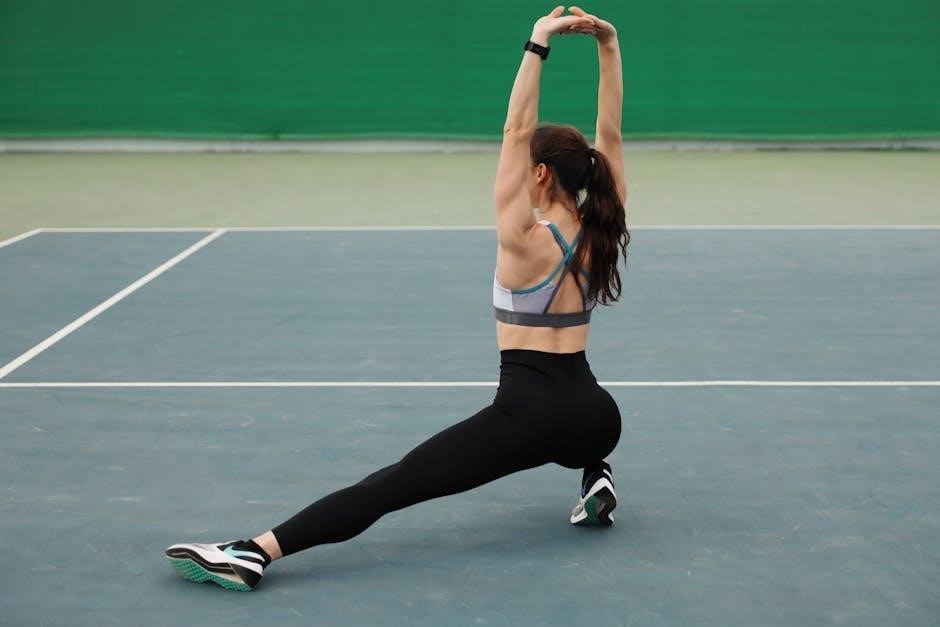
Strengthening Exercises for Vastus Medialis
Strengthening exercises for the vastus medialis include isometrics, inner range quadriceps sets, and straight leg raises. These exercises enhance knee stability, improve muscle activation, and reduce injury risk effectively.
3.1 Isometric Vastus Medialis Exercises
Isometric vastus medialis exercises are effective for initial strengthening without joint movement. Sit with a rolled towel under the knee, contract the quadriceps, and press the knee into the towel. Hold for 5-10 seconds, repeat 10-15 times. This exercise enhances muscle activation and knee stability. It is ideal for individuals with limited mobility or post-injury recovery. Isometric exercises promote controlled strengthening and reduce strain on the knee joint. Regular practice improves vastus medialis activation, crucial for preventing patellofemoral pain syndrome. These exercises are often recommended in early rehabilitation phases to rebuild strength safely and effectively.
3.2 Inner Range Quadriceps Strengthening
Inner range quadriceps strengthening focuses on activating the vastus medialis during the final stages of knee extension. This exercise involves lying on your back with a towel under the knee, tightening the quadriceps to lift the heel while keeping the knee straight. It targets the lower portion of the quads, particularly the vastus medialis, improving knee stability and function. This method is beneficial for individuals with knee osteoarthritis or patellofemoral pain syndrome. Regular practice enhances muscle activation and reduces cartilage loss, lowering the risk of joint replacement. Inner range exercises are a key component of rehabilitation programs, promoting strength and stability without excessive strain on the knee joint.
3.3 Straight Leg Raises for VMO Activation
Straight leg raises are an effective exercise for activating the vastus medialis oblique (VMO). To perform this exercise, lie on your back with one leg straight and the other bent. Slowly lift the straight leg to the height of the bent knee, keeping it fully extended. Focus on tightening the VMO muscle during the movement. This exercise is particularly beneficial for improving patellar tracking and reducing knee pain. It is often included in rehabilitation programs for knee injuries or osteoarthritis. The straight leg raise strengthens the VMO without placing excessive stress on the knee joint, making it an ideal choice for individuals in the early stages of recovery or those with limited mobility.
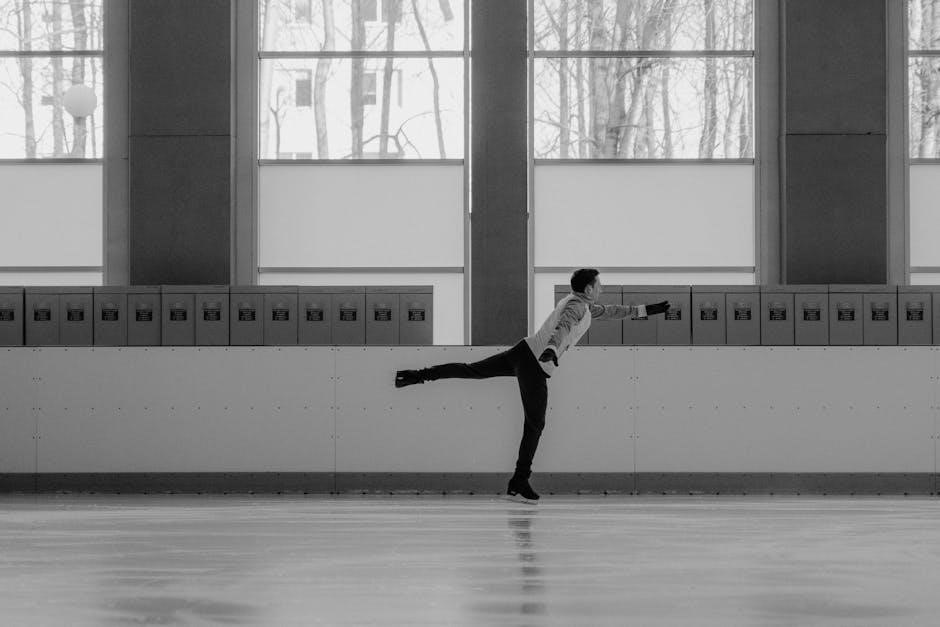
Rehabilitation Programs for Vastus Medialis
Rehabilitation programs for vastus medialis focus on restoring strength and function through structured exercises. These include isometric exercises, progressions, and activities to enhance knee stability and mobility.
4.1 8-Step Rehabilitation Program Overview
The 8-step rehabilitation program for vastus medialis focuses on progressive strengthening and functional recovery. It begins with non-weight-bearing isometric exercises to activate the VMO, followed by inner range quadriceps strengthening to enhance knee stability. The third step introduces straight leg raises to target the VMO without putting stress on the knee joint. As the program progresses, weight-bearing exercises like mini squats and step-ups are incorporated to improve functional strength. Dynamic exercises, such as resistance band work, are added to challenge the muscle further. The final steps involve advanced activities like balance training and plyometrics to restore full knee function. Regular monitoring and gradual intensity adjustments ensure safe and effective recovery.
4.2 Progression of Exercises in Rehabilitation
Exercise progression in vastus medialis rehabilitation follows a structured approach to ensure optimal recovery. Initial phases focus on isometric exercises, such as quadriceps sets and straight leg raises, to activate the VMO without joint stress. As strength improves, resistance is added using elastic bands or light weights. The next phase introduces weight-bearing exercises like mini squats and step-ups to enhance functional strength. Dynamic movements, such as leg presses and balance training, are incorporated to improve stability and coordination. Advanced stages include plyometric exercises to restore explosive power. Throughout the program, exercises are tailored to individual progress, ensuring a gradual increase in intensity and complexity to prevent overtraining and promote sustained recovery.
4.3 Role of Vastus Medialis in Post-Injury Recovery
The vastus medialis plays a crucial role in post-injury recovery by restoring knee stability and function. Strengthening this muscle helps alleviate pain and prevents further injury, particularly in cases of patellofemoral pain syndrome. After trauma or surgery, targeted exercises like straight leg raises and isometric contractions reactivate the VMO, ensuring proper patellar tracking. This muscle’s activation is essential for regaining strength and mobility, enabling patients to progress from non-weight-bearing to dynamic activities. Consistent VMO training reduces the risk of chronic knee issues and supports the overall rehabilitation process, making it a cornerstone of effective post-injury recovery strategies.

Advanced Training Techniques
Advanced techniques include resistance bands, squat variations, and gym ball exercises to enhance VMO activation and overall lower limb strength, improving muscle engagement and functional movement patterns effectively.
5.1 Resistance Band Exercises for VMO
Resistance band exercises are highly effective for targeting the vastus medialis oblique (VMO). These exercises involve looping a resistance band around a stable object or under the foot, with the individual sitting or standing. By contracting the quadriceps and extending the knee against the band’s resistance, the VMO is activated. Proper form is crucial to avoid overtraining and muscle strain. Studies suggest that using thicker bands or increasing tension enhances muscle engagement. Performing 3-4 sets of 15 repetitions is recommended. This method is particularly beneficial for individuals with knee osteoarthritis, as it strengthens the muscle without excessive joint stress. Consistency in these exercises leads to improved knee stability and reduced pain over time.
5.2 Squat Variations for Vastus Medialis Activation
Squat variations are excellent for activating the vastus medialis, particularly when proper form and muscle engagement are prioritized. Bodyweight squats, weighted squats, and split squats are common variations that target the VMO. By maintaining an upright posture and engaging the quadriceps during the movement, individuals can effectively isolate the vastus medialis. Studies suggest that incorporating tools like gym balls or elastic bands during squats enhances VMO activation. These exercises not only strengthen the muscle but also improve knee stability and overall lower limb function. Consistent practice of squat variations can lead to significant improvements in muscle strength and joint health, making them a cornerstone of vastus medialis training programs.
5.3 Use of Gym Balls and Elastic Bands
Gym balls and elastic bands are versatile tools for enhancing vastus medialis activation. Gym balls provide instability, engaging the VMO for improved knee stability during exercises like wall squats or seated marches. Elastic bands offer resistance, intensifying workouts such as banded leg extensions or side-lying leg lifts. Studies show that using these tools increases muscle activation compared to traditional exercises. They are particularly effective in rehabilitation settings, where controlled resistance and progressive overload are crucial. Incorporating gym balls and elastic bands into routines can optimize VMO strengthening, leading to better knee function and reduced injury risk. These tools are cost-effective and adaptable, making them ideal for both home and clinical exercises focused on vastus medialis development.
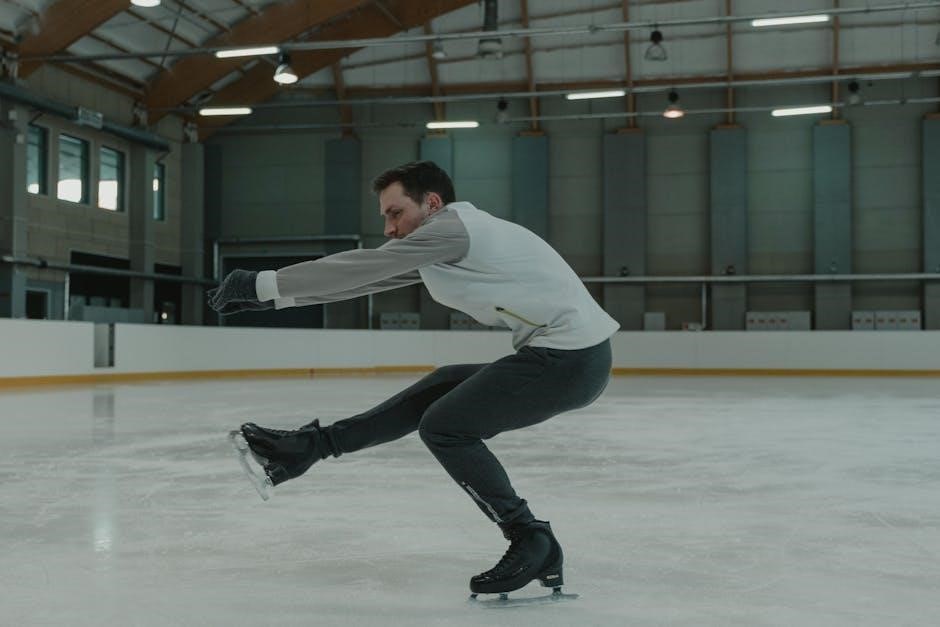
Vastus Medialis Exercises for Knee Osteoarthritis
Vastus medialis exercises are crucial for managing knee osteoarthritis, reducing pain, improving function, and lowering joint replacement risk by strengthening the muscle and stabilizing the knee.
6.1 Exercise Programs to Reduce Pain and Improve Function
Exercise programs targeting the vastus medialis are essential for managing knee osteoarthritis, focusing on reducing pain and enhancing functional mobility. These programs often include isometric exercises, such as quadriceps sets and straight leg raises, which strengthen the muscle without putting excessive strain on the knee joint. Inner range quadriceps strengthening is also commonly recommended, as it activates the vastus medialis oblique (VMO) effectively. Progression to weight-bearing exercises, like mini squats or step-ups, can further improve joint stability and reduce pain. Consistency in these exercises helps prevent cartilage loss and enhances overall knee function, making daily activities easier for individuals with osteoarthritis. Regular practice of these exercises, tailored to individual needs, is crucial for long-term benefits and improved quality of life.
6.2 Strengthening Exercises to Prevent Cartilage Loss
Strengthening the vastus medialis is critical for preventing cartilage loss in knee osteoarthritis. Exercises like straight leg raises and inner range quadriceps strengthening target the VMO, enhancing muscle activation and joint stability. Resistance band exercises and controlled leg extensions further strengthen the muscle, reducing stress on the knee joint. These exercises promote even distribution of forces, minimizing cartilage wear. Consistent practice helps maintain cartilage health and delays degeneration. Combining these with low-impact activities, such as cycling or swimming, supports joint health without excessive strain. Strengthening the vastus medialis is a proactive approach to preserving knee function and preventing cartilage loss, essential for long-term joint health and mobility.
6.3 Role of VMO in Reducing Joint Replacement Risk
The vastus medialis oblique (VMO) plays a pivotal role in reducing the risk of joint replacement by enhancing knee stability and reducing cartilage wear. Strengthening the VMO through targeted exercises, such as straight leg raises and resistance band workouts, improves joint mechanics and alleviates stress on the knee. Studies indicate that increased VMO activation and muscle cross-sectional area are associated with reduced pain and delayed cartilage loss in osteoarthritis patients. By stabilizing the patella and promoting even load distribution, VMO strengthening can significantly lower the likelihood of requiring surgical interventions like joint replacement. Regular exercise programs tailored to VMO activation are thus essential for preserving knee health and maintaining functional mobility in individuals at risk of severe joint degeneration.
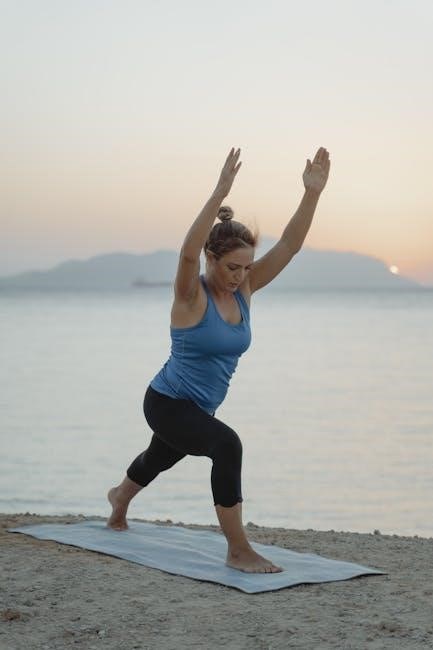
Safety and Precautions
Ensure proper form to avoid muscle strain. Monitor progress and adjust intensity gradually. Avoid overtraining to prevent injury, and use tools like gym balls and bands safely.
7.1 Proper Form and Technique in Exercises
Proper form and technique are crucial when performing vastus medialis exercises to prevent injury and maximize effectiveness. For isometric exercises, such as the seated towel press, ensure the knee remains stable and the quadriceps muscle is fully engaged without lifting the foot. Maintain a straight line from the heel to the knee to avoid straining the joint. When performing inner range quadriceps strengthening, focus on slow, controlled movements, keeping the leg in line with the body. Using tools like gym balls or elastic bands requires careful positioning to target the correct muscle fibers. Correct alignment prevents unnecessary stress on the knee joint, promoting safe and efficient muscle activation. Consistent proper form ensures long-term benefits and reduces the risk of overuse injuries.
7.2 Avoiding Overtraining and Muscle Strain
Avoiding overtraining and muscle strain is essential to prevent injuries and ensure effective vastus medialis exercises. Start with low resistance and gradually increase intensity to allow muscle adaptation. When using resistance bands, adjust the thickness or distance to avoid excessive strain. During isometric exercises, maintain proper form to prevent unnecessary stress on the knee joint. Monitor progress and adjust intensity based on muscle response. Overtraining can lead to fatigue and reduced effectiveness, so incorporate rest days to promote recovery. Pay attention to signs of strain, such as pain or discomfort, and modify exercises as needed. Proper progression and moderation ensure a safe and effective workout routine for vastus medialis strengthening.
7.3 Monitoring Progress and Adjusting Intensity
Monitoring progress and adjusting intensity are crucial for effective vastus medialis training. Track the number of repetitions, sets, and resistance used in exercises like inner range quadriceps and straight leg raises. Gradually increase intensity as strength improves, ensuring proper form is maintained. For resistance band exercises, adjust the band’s thickness or tension to challenge the muscle without causing strain. Regularly assess muscle activation and technique, especially during squats and VMO-focused movements. If progress stalls, consider incorporating advanced techniques like gym ball or elastic band variations. Adjusting intensity ensures continuous improvement while minimizing the risk of plateaus or overtraining. Always consult a professional to tailor exercises to individual progress and goals. This approach ensures a balanced and effective workout routine.
Vastus medialis exercises are essential for knee stability, reducing pain, and preventing cartilage loss. Consistent training enhances long-term joint health, emphasizing proper technique and progressive intensity for optimal results.
8.1 Summary of Key Benefits of Vastus Medialis Training

Vastus medialis training enhances knee stability, reduces pain, and improves functional mobility. It strengthens the VMO, crucial for patellar tracking and joint health. Regular exercises prevent cartilage loss, lower osteoarthritis risks, and support post-injury recovery. Consistent training promotes long-term joint integrity and overall lower limb function, making it essential for athletes and individuals with knee conditions. Proper form and progression are key to maximizing benefits and preventing strain. Incorporating exercises like isometric holds and straight leg raises can significantly improve knee function and reduce the risk of future injuries. Over time, this training fosters stronger, more resilient knees, enhancing quality of life and physical performance.
8.2 Long-Term Effects of Consistent Exercise Routine
A consistent vastus medialis exercise routine yields lasting benefits, including improved knee joint stability and reduced pain over time. Regular activation of the VMO strengthens the muscle, enhancing patellar tracking and lowering the risk of degenerative conditions like osteoarthritis. Long-term adherence to exercises such as squats, straight leg raises, and isometric holds increases muscle endurance and promotes balanced quadriceps development. This leads to better overall lower limb function, reducing the likelihood of injuries and improving mobility. Consistent training also supports cartilage health, delaying potential degeneration and the need for surgical interventions. Over time, these exercises contribute to sustained physical performance and a reduced risk of knee-related issues, emphasizing the importance of maintaining a regular exercise regimen.
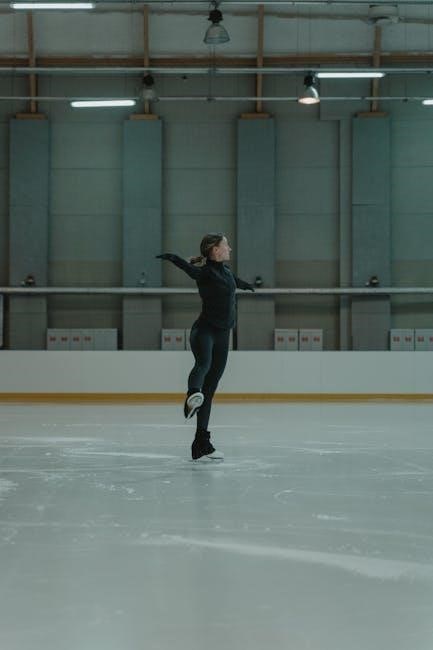
8.3 Final Tips for Effective Vastus Medialis Workouts

For effective vastus medialis workouts, start with isometric exercises to build foundational strength. Incorporate variations like squats and straight leg raises to target the VMO specifically. Use resistance bands or gym balls to add challenge and improve activation. Focus on proper form to avoid muscle strain and ensure optimal engagement. Avoid overtraining by gradually increasing intensity and monitoring progress. Consistency is key, so maintain a regular routine to achieve long-term benefits. Finally, combine vastus medialis exercises with a balanced lower body workout to enhance overall knee stability and reduce injury risk. Proper cueing and awareness of muscle activation will maximize results and support knee health.